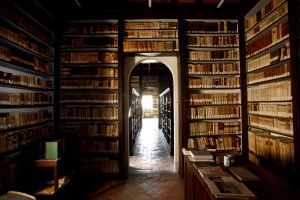The Basilica of St Bernardino all'Osservanza
The Library
The first core of the library formed in Saint Bernardino’s days and towards the end of the fifteenth century the collection was already noteworthy. It was constantly augmented through the activity of the scriptorium, which was also established by the saint. The amount of books increased until the eighteenth century, with a predominance of books on Theology, Patristics, Canon Law and History of the Church and of the Order.
Just like the artistic heritage of the monastery, the books also follow the fortunes of the friar’s community: the 1810 Napoleonic suppression and the second suppression in 1866 result in the auction of numerous books and the relocation of others to Siena’s Municipal Library.
Afterwards the collection gradually built up again through restitutions and bequests, and was preserved by Father Aurelio Castelli, who also managed to buy back part of the sold items, re-establishing the library in 1874.
The library currently contains 25.000 tomes, which may be consulted electronically through the catalogues of Siena’s integrated library system. The collection also boasts a few ancient volumes: some fifteen-century incunabula including a Roman breviary published in Venice in 1478; the Historia Florentia by Poggio Bracciolini of 1498 and, from the same year, the Sermones del Evangelio aeterno by Saint Bernardino.
Just like the artistic heritage of the monastery, the books also follow the fortunes of the friar’s community: the 1810 Napoleonic suppression and the second suppression in 1866 result in the auction of numerous books and the relocation of others to Siena’s Municipal Library.
Afterwards the collection gradually built up again through restitutions and bequests, and was preserved by Father Aurelio Castelli, who also managed to buy back part of the sold items, re-establishing the library in 1874.
The library currently contains 25.000 tomes, which may be consulted electronically through the catalogues of Siena’s integrated library system. The collection also boasts a few ancient volumes: some fifteen-century incunabula including a Roman breviary published in Venice in 1478; the Historia Florentia by Poggio Bracciolini of 1498 and, from the same year, the Sermones del Evangelio aeterno by Saint Bernardino.




